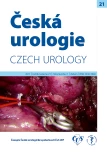THE USE OF SUBY G IRRIAGION SYSTEM IN PATIENTS WITH NEUROGENIC LOWER URINARY TRACT DYSFUNCTION AND LONGTERM INDWELLING CATHETER
Authors:
Alena Kyrianová 1; Vladimír Šámal 2,3; Jaroslav Šrám 1; Jan Mečl 2
Authors‘ workplace:
Spinální jednotka, Traumatologicko‑ortopedické centrum, Krajská nemocnice Liberec, a. s.
1; Urologické oddělení, Krajská nemocnice Liberec, a. s.
2; Urologická klinika FN a LF UK, Hradec Králové
3
Published in:
Ces Urol 2017; 21(1): 65-72
Category:
Original Articles
Overview
Aim:
Despite of advanced treatment of neurogenic lower urinary tract dysfunction there is a not inconsiderable group of patients reliant on long-term or permanent urinary diversion using indweling urinary catheter (IC). IC increase the risk of urinary tract infection and infections with ureasplitting strains can cause catheter encrustation and catheter blockage. Preventive measures include frequent changes of IC, treatment of urinary infections and acidification of urine.
Methods:
In this prospective study, we randomized 43 patients. The first group had inserted a IC with standard care. In the second group the bladder was washed out twice weekly using URO TAINER® Suby G solution for 10 minutes. The catheter was changed in both groups after 21 days. The period of study was 9 weeks and the endpoint was the number of catheter encrustations caused by Proteus mirabilis, Pseudomonas aeruginosa, Klebsiela pnemumoniae and Providencia species and the incidence of symptomatic urinary tract infection.
Results:
In the group with catheter washout, we recorded significantly fewer episodes of catheter encrustation (p-value = 0.009). Also the number of symptomatic urinary tract infections in the group with wash-out was significantly lower. Two patients in the wash-out group did not complete the study due to adverse events.
Conclusion:
Preventive catheter wash-out in the group of patients with neurogenic lower urinary tract dysfunction led to significant reductions in episodes of catheter encrustation and significant reductions in the rate of symptomatic urinary tract infection.
KEY WORDS:
Indweling catheter, urinary tract infection, blockage of urethral catheter, urethral catheter encrustation, wash-out system.
Sources
1. Hooton TM, Bradley SF, Cardenas DD, Colgan R, Geerlings SE, et al. Diagnosis, prevention, and treatment of catheter-associated urinary tract infection in adults: 2009 International Clinical Practice Guidelines from the Infectious Diseases Society of America. Clin Infect Dis 2010; 50(5): 625–663.
2. Heráček J, Urban M, Sobotka V, Novotný T, Lukeš M, et al. Urologické komplikace poranění míchy. Postgraduální medicína: odborný časopis pro lékaře 2007; 9(9): 957–964.
3. Jacobsen SM, Stickler DJ, Mobley HL, Shirtliff ME. Complicated catheter-associated urinary tract infections due to Escherichia coli and Proteus mirabilis. Clin Microbiol Rev 2008; 21(1): 26–59.
4. Saint S, Chenoweth CE. Biofilms and catheter-associated urinary tract infections. Infect Dis Clin North Am 2003; 17(2): 411–432.
5. Morris NS, Stickler DJ. Encrustation of indwelling urethral catheters by Proteus mirabilis biofilms growing in human urine. J Hosp Infect 1998; 39(3): 227–234.
6. Kunin CM. Blockage of urinary catheters: role of microorganisms and constituents of the urine on formation of encrustations. J Clin Epidemiol 1989; 42(9): 835–842.
7. Getliffe KA, Hughes SC, Le Claire M. The dissolution of urinary catheter encrustation. BJU Int 2000; 85(1): 60–64.
8. Moore KN, Hunter KF, McGinnis R, et al. Do catheter washouts extend patency time in long-term indwelling urethral catheters? A randomized controlled trial of acidic washout solution, normal saline washout, or standard care. J Wound Ostomy Continence Nurs 2009; 36(1): 82–90.
9. Kennedy AP, Brocklehurst JC, Robinson JM, Faragher EB. Assessment of the use of bladder washouts/instillations in patients with long-term indwelling catheters. Br J Urol 1992; 70(6): 610–615.
10. Muncie HL, Jr, Hoopes JM, Damron DJ, Tenney JH, Warren JW. Once-daily irrigation of long-term urethral catheters with normal saline. Lack of benefit. Arch Intern Med 1989; 149(2): 441–443.
11. Wyndaele JJ. The encrustation and blockage of longterm indwelling catheters. Spinal Cord 2010; 48(11): 783.
12. Morris NS, Stickler DJ, McLean RJ. The development of bacterial biofilms on indwelling urethral catheters. World J Urol 1999; 17(6): 345–350.
13. Pickard R, Lam T, MacLennan G, et al. Antimicrobial catheters for reduction of symptomatic urinary tract infection in adults requiring short-term catheterisation in hospital: a multicentre randomised controlled trial. Lancet 2012; 380(9857): 1927–1935.
14. Pickard R, Lam T, Maclennan G, et al. Types of urethral catheter for reducing symptomatic urinary tract infections in hospitalised adults requiring short-term catheterisation: multicentre randomised controlled trial and economic evaluation of antimicrobial- and antiseptic-impregnated urethral catheters (the CATHETER trial). Health Technol Assess 2012; 16(47): 1–197.
15. Meddings J, Rogers MA, Krein SL, et al. Reducing unnecessary urinary catheter use and other strategies to prevent catheter-associated urinary tract infection: an integrative review. BMJ Qual Saf 2014; 23(4): 277–289.
16. Grahn D, Norman DC, White ML, Cantrell M, Yoshikawa TT. Validity of urinary catheter specimen for diagnosis of urinary tract infection in the elderly. Arch Intern Med 1985; 145(10): 1858–1860.
17. Tenney JH, Warren JW. Bacteriuria in women with long-term catheters: paired comparison of indwelling and replacement catheters. J Infect Dis 1988; 157(1): 199–202.
18. Classen DC, Larsen RA, Burke JP, Stevens LE. Prevention of catheter-associated bacteriuria: clinical trial of methods to block three known pathways of infection. Am J Infect Control 1991; 19(3): 136–142.
19. Warren JW, Damron D, Tenney JH, et al. Fever, bacteremia, and death as complications of bacteriuria in women with long-term urethral catheters. J Infect Dis 1987; 155(6): 1151–1158.
20. Wyndaele JJ. Complications of intermittent catheterization: their prevention and treatment. Spinal Cord 2002; 40(10): 536–541.
21. Peterson AC, Curtis LH, Shea AM, et al. Urinary diversion in patients with spinal cord injury in the United States. Urology 2012; 80(6): 1247–1251.
Labels
Paediatric urologist Nephrology UrologyArticle was published in
Czech Urology

2017 Issue 1
Most read in this issue
- Modifications of laparoscopic ureterocystoneostomy
- PEYRONIE´S DISEASE
- THE ROLE OF PSYCHOSOMATICS IN UROLOGY
- RARE CYSTADENOCARCIONOMA OF PROSTATE, CLINICAL APPEARANCE, DIAGNOSTIC PROCEDURES AND TREATMENT
